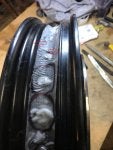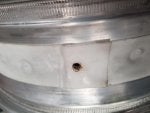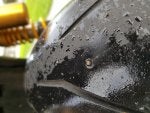G'day all,
My new Avon AM26 front tyre arrived so I took the opportunity to install it tubeless. To me there seems to be no downside to tubeless with ease of repair, less mass and slower deflation in the event of a puncture.
I had already purchased clamp-on tubeless valves out of UK on eBay ,but had I been thinking would have gone for angled stems. Too bad , too late but definitely something for the next swap.
All the research I've done leads to using 3M 4411N Extreme Seal tape to seal up the spoke nipples. So I tracked this stuff down at Blackwoods and paid about 30 bucks for a 35mm wide by 5m roll. This is enough for 3 wheels.
It's also worth noting that some of the cycling types also use plain old-fashioned Gorilla tape for this purpose and they're usually running pressures up about 70 PSI.
I do know that firms which do this commercially will not do so if the rim does not have a "safety bead" . I looked up what was meant by this and it's actually on the T120 rims and is highlighted with arrows in one of my attached images. Once you look at it it becomes pretty obvious what it's intended to do. And the tyre makes a healthy "pop" as it goes over them on initial inflation.
So I hoisted the bike up on the lift. It will lift without damaging the sump guard if done carefully and stays still enough to work on with a precautionary ratchet strap.
You'll need a 17mm internal hex drive to remove the front axle - I thought the project had stalled there until I remembered my set of sump-plug sockets which I got on special at Super Cheap , and there it was !
Wheel taken off and original Pirelli and tube removed - time to clean and degrease in preparation for taping. I started out with Acetone , carefully , and then went to meths. 3M recommends isopropyl alcohol , so meths is close enough. Don't skimp on this - get in there with a toothbrush if you have to - later in the write up it will become obvious why. :laugh2:
The most difficult part of the process is laying the tape into the trough without it grabbing the sides. You could try and keep it on the roll and bending it up both sides but I simply run out of hands . It's easier to do this in short lengths but that's not a lot of help.
Perhaps the 25mm / 1" stuff would be easier?
I went around the wheel massaging the tape outwards from the centre with my thumbs and had the inevitable bubbles form . This after removing the backing plastic . The tape is quite spongy and ductile and as long as you get a good seal around each nipple the bubbles will not matter a lot but they can be pushed to the edge.
Butt joined the ends at the valve penetration and placed a doubler of tape over them, as per the most popular method. I ran one over the other and used a craft knife to trim both. Wouldn't bother doing it again - Just overlapping seems to work fine and the stuff doesn't have enough mass to affect balance.
So after all this I fitted the new rubber and with these Avons there does not seem to be any particular "opposite or next-to " the valve marking , so I 'd assume fairly neutral balance.
What I should have done at this stage after inflation is the soapy water test! It's not like I didn't have it handy and I was to pay for this lapse of judgement and "press on" mindset.
All back together and spinning the wheel on the forks with the calipers dismounted showed what appears to be a nice neutral balance. This seems to hold true while riding up to 100kph.
But in the morning a flat tyre! Out with the soapy water which showed slow leaks around 2 spokes ;- these marked and tyre removed -again! At least I'm getting pretty good at it .
A casual inspection of the tape revealed a couple of decent bubbles going all the way to the edge as shown in the pics. 3M product good / the installer not quite so!
A new section of tape placed after a further degrease and to do the belt and braces thing , some gaffer tape over the lot , if nothing else just to protect the 3M during tyre fitting.
And a thorough going over with the soapy water at 40 PSI reveals no leaks. You'll notice in the pics that air pressure has largely done what thumbs can not in compressing the tape onto the wheel surface. Its all back on the bike now and I'm liking having new front rubber.
I have been hunting road surface joins and linear gouges and the Avons seem to be a lot better at resisting tracking than the factory Pirellis thus far - something I notice with my T140 which also has AM26's , and the ride is nice.
These are bias-ply just like the Pirelli Sportcomp it replaces but you could easily fit any radial you desire.
Pretty sure some of the people that do this for a living might be having a chuckle but it works! :grin2:
Pic 1 DIY bead breaker - all of about 2 minutes to make and it works perfectly with a block quickly nailed to my bench.
Pic 2 Bubbles highlighted with felt marker after first fitting. Arrows to safety beads. Tape definitely more transparent than before inflation.
Pic 3 New section of 3M tape placed after removal of leaky section - about 1" overlap at ends,- gaffer tape over all.
Pic 4 Bonnie on lift . Squiggly plastic coated wires from Bunnings supporting calipers . Wooden wedges separating brake pads. iPad sideways photo - don't know why it does that when it's normal orientation on my device? Anyway you get the idea.
Pic 5 Job done and soaking with soapy water.
My new Avon AM26 front tyre arrived so I took the opportunity to install it tubeless. To me there seems to be no downside to tubeless with ease of repair, less mass and slower deflation in the event of a puncture.
I had already purchased clamp-on tubeless valves out of UK on eBay ,but had I been thinking would have gone for angled stems. Too bad , too late but definitely something for the next swap.
All the research I've done leads to using 3M 4411N Extreme Seal tape to seal up the spoke nipples. So I tracked this stuff down at Blackwoods and paid about 30 bucks for a 35mm wide by 5m roll. This is enough for 3 wheels.
It's also worth noting that some of the cycling types also use plain old-fashioned Gorilla tape for this purpose and they're usually running pressures up about 70 PSI.
I do know that firms which do this commercially will not do so if the rim does not have a "safety bead" . I looked up what was meant by this and it's actually on the T120 rims and is highlighted with arrows in one of my attached images. Once you look at it it becomes pretty obvious what it's intended to do. And the tyre makes a healthy "pop" as it goes over them on initial inflation.
So I hoisted the bike up on the lift. It will lift without damaging the sump guard if done carefully and stays still enough to work on with a precautionary ratchet strap.
You'll need a 17mm internal hex drive to remove the front axle - I thought the project had stalled there until I remembered my set of sump-plug sockets which I got on special at Super Cheap , and there it was !
Wheel taken off and original Pirelli and tube removed - time to clean and degrease in preparation for taping. I started out with Acetone , carefully , and then went to meths. 3M recommends isopropyl alcohol , so meths is close enough. Don't skimp on this - get in there with a toothbrush if you have to - later in the write up it will become obvious why. :laugh2:
The most difficult part of the process is laying the tape into the trough without it grabbing the sides. You could try and keep it on the roll and bending it up both sides but I simply run out of hands . It's easier to do this in short lengths but that's not a lot of help.
Perhaps the 25mm / 1" stuff would be easier?
I went around the wheel massaging the tape outwards from the centre with my thumbs and had the inevitable bubbles form . This after removing the backing plastic . The tape is quite spongy and ductile and as long as you get a good seal around each nipple the bubbles will not matter a lot but they can be pushed to the edge.
Butt joined the ends at the valve penetration and placed a doubler of tape over them, as per the most popular method. I ran one over the other and used a craft knife to trim both. Wouldn't bother doing it again - Just overlapping seems to work fine and the stuff doesn't have enough mass to affect balance.
So after all this I fitted the new rubber and with these Avons there does not seem to be any particular "opposite or next-to " the valve marking , so I 'd assume fairly neutral balance.
What I should have done at this stage after inflation is the soapy water test! It's not like I didn't have it handy and I was to pay for this lapse of judgement and "press on" mindset.
All back together and spinning the wheel on the forks with the calipers dismounted showed what appears to be a nice neutral balance. This seems to hold true while riding up to 100kph.
But in the morning a flat tyre! Out with the soapy water which showed slow leaks around 2 spokes ;- these marked and tyre removed -again! At least I'm getting pretty good at it .
A casual inspection of the tape revealed a couple of decent bubbles going all the way to the edge as shown in the pics. 3M product good / the installer not quite so!
A new section of tape placed after a further degrease and to do the belt and braces thing , some gaffer tape over the lot , if nothing else just to protect the 3M during tyre fitting.
And a thorough going over with the soapy water at 40 PSI reveals no leaks. You'll notice in the pics that air pressure has largely done what thumbs can not in compressing the tape onto the wheel surface. Its all back on the bike now and I'm liking having new front rubber.
I have been hunting road surface joins and linear gouges and the Avons seem to be a lot better at resisting tracking than the factory Pirellis thus far - something I notice with my T140 which also has AM26's , and the ride is nice.
These are bias-ply just like the Pirelli Sportcomp it replaces but you could easily fit any radial you desire.
Pretty sure some of the people that do this for a living might be having a chuckle but it works! :grin2:
Pic 1 DIY bead breaker - all of about 2 minutes to make and it works perfectly with a block quickly nailed to my bench.
Pic 2 Bubbles highlighted with felt marker after first fitting. Arrows to safety beads. Tape definitely more transparent than before inflation.
Pic 3 New section of 3M tape placed after removal of leaky section - about 1" overlap at ends,- gaffer tape over all.
Pic 4 Bonnie on lift . Squiggly plastic coated wires from Bunnings supporting calipers . Wooden wedges separating brake pads. iPad sideways photo - don't know why it does that when it's normal orientation on my device? Anyway you get the idea.
Pic 5 Job done and soaking with soapy water.



















